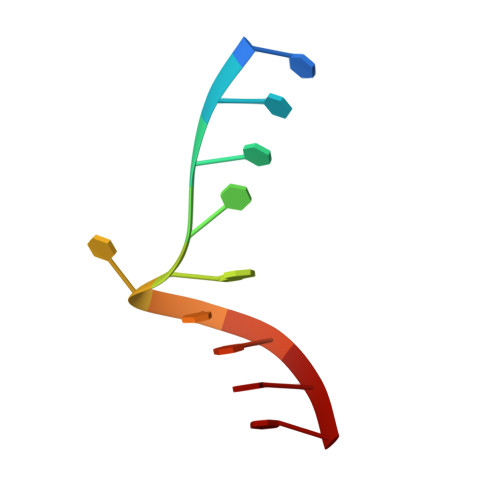Description of ordered solvent molecules in a platinated decanucleotide duplex refined at 1.6A resolution against experimental MAD phases.
Coste, F., Shepard, W., Zelwer, C.(2002) Acta Crystallogr D Biol Crystallogr 58: 431-440
- PubMed: 11856828
- DOI: https://doi.org/10.1107/s0907444901021709
- Primary Citation of Related Structures:
1I1P - PubMed Abstract:
Accurate experimental phases derived from a MAD experiment may be useful to enable the identification of solvent molecules during the course of an atomic parameter refinement. The structure of a double-stranded DNA decanucleotide bearing a cisplatin interstrand cross-link at 1.6A resolution, whose phases were first determined experimentally using the L(III) edge of the Pt atom, was refined by various methods. The previously published structure resulted from a least-squares refinement using the structure-factor magnitudes and stereochemical restraints (program SHELX). In this paper, these previous results are compared with a model obtained by the likelihood-maximization method (program REFMAC) which allows the combination of the observed magnitudes with experimental MAD phases. This solution corresponded to a lower R(free) (18.8 compared with 20.3%), a lower R factor and accounted for 135 water molecules and one spermine molecule collected by the program wARP during refinement. The previously published SHELX solution exhibited no spermine molecule and accounted for 92 water molecules, only 74 of which are also present in the model obtained with the MAD phases. In order to verify that these improvements were actually related to the use of the MAD phases, the same type of procedure without the MAD phases was applied starting from the initial model. The resulting solution had a higher R(free) (20.3%), which could be related to the loss of 22 water molecules and the addition of 20 new ones. MAD phases therefore seem especially helpful in preventing the model bias which may affect the solvent molecules. All models have in common a hydration cage of nine water molecules which surround the platinum residue. In addition to the spermine molecule, the model obtained with the MAD phases allows description of the water-molecule organization, with reproducible motifs related to the base pairs and to the phosphodiester backbone.
Organizational Affiliation:
Centre de Biophysique Moléculaire, Centre National de la Recherche Scientifique, University of Orléans and Institut National de la Santé et de la Recherche Médicale, Rue Charles Sadron, 45071 Orléans CEDEX 2, France.

















